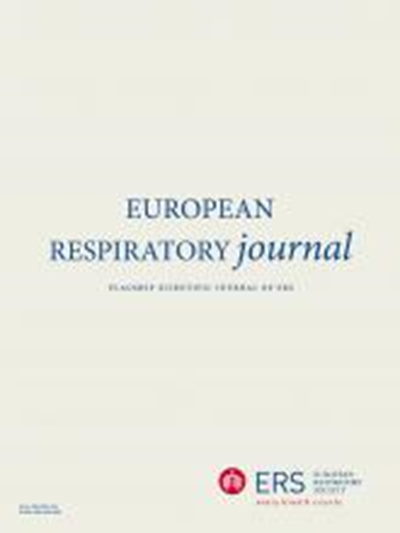selexipag对无法手术或持续/复发性CTEPH患者的疗效和安全性(SELECT随机试验)。
IF 16.6
1区 医学
Q1 RESPIRATORY SYSTEM
引用次数: 0
摘要
背景SELECT是一项多中心、随机、双盲、安慰剂对照、平行组、分组序列的3期研究(NCT03689244)。年龄≤85岁、WHO功能分级为I-IV级、6分钟步行距离(6 MWD)为100-450米的成人被随机(1:1)分配到接受selexipag(200-1600微克/次,滴定至个人最大耐受剂量)+标准治疗或安慰剂+标准治疗。患者被纳入血流动力学组(首批接受右心导管检查 [RHC] 的 91 名随机患者;第 20 周)或非血流动力学组(其余患者,无需接受右心导管检查)。主要终点是基线肺血管阻力(PVR;第20周)的百分比。结果 在筛选出的 321 名患者中,128 人接受了随机治疗(血流动力学组:91 人[selexipag:47 人;安慰剂:44 人])。在血流动力学组中,29 名患者(31.9%)曾接受过肺动脉内膜切除术(PEA),20 名患者(22.0%)接受过球囊肺血管成形术(BPA),14 名患者(15.4%)同时接受过 PEA 和 BPA;28 名患者(30.8%)无法手术。由于在主要终点(治疗间 PVR 几何最小二乘法均值比:0.95 [95% CI 0.84, 1.07; p=0.412])上未观察到统计学上的显著差异,独立数据监控委员会建议以徒劳为由停止研究。selexipag和安慰剂分别有63例(98.4%)和53例(82.8%)患者出现不良事件。安全性数据与 Selexipag 既定的安全性特征一致,未发现新的安全性信号。本文章由计算机程序翻译,如有差异,请以英文原文为准。
Efficacy and safety of selexipag in patients with inoperable or persistent/recurrent CTEPH (SELECT randomised trial).
BACKGROUND
SELECT was the first global randomised controlled trial of selexipag with standard of care in patients with inoperable or persistent/recurrent chronic thromboembolic pulmonary hypertension.
METHODS
SELECT was a multicentre, randomised, double-blind, placebo-controlled, parallel-group, group-sequential, phase 3 study (NCT03689244). Adults aged ≤85 years in WHO functional class I-IV, with a 6-minute walk distance (6 MWD) of 100-450 m, were randomised (1:1) to receive selexipag (200-1600 µg b.i.d. titration until individual maximum tolerated dose)+standard of care or placebo+standard of care. Patients were recruited into the haemodynamic set (first 91 randomised patients to undergo right heart catheterisation [RHC]; Week 20) or non-haemodynamic cohort (remaining patients, no RHC required). Primary endpoint was percent of baseline pulmonary vascular resistance (PVR; Week 20). Safety was also assessed.
RESULTS
Of 321 patients screened, 128 were randomised (haemodynamic set: n=91 [selexipag: n=47; placebo: n=44]). In the haemodynamic set, 29 (31.9%) patients had previous pulmonary endarterectomy (PEA), 20 (22.0%) balloon pulmonary angioplasty (BPA), and 14 (15.4%) both PEA and BPA; 28 (30.8%) were inoperable. The Independent Data Monitoring Committee recommended to stop the study for futility as no statistically significant difference was observed for the primary endpoint (between-treatment geometric least squares mean ratio of PVR: 0.95 [95% CI 0.84, 1.07; p=0.412]). Adverse events were reported in 63 (98.4%) and 53 (82.8%) patients for selexipag and placebo, respectively.
CONCLUSION
SELECT was discontinued for futility, as no treatment effect on the primary endpoint (PVR) was observed. Safety data were consistent with the established safety profile of selexipag, with no new safety signals identified.
求助全文
通过发布文献求助,成功后即可免费获取论文全文。
去求助
来源期刊

European Respiratory Journal
医学-呼吸系统
CiteScore
27.50
自引率
3.30%
发文量
345
审稿时长
2-4 weeks
期刊介绍:
The European Respiratory Journal (ERJ) is the flagship journal of the European Respiratory Society. It has a current impact factor of 24.9. The journal covers various aspects of adult and paediatric respiratory medicine, including cell biology, epidemiology, immunology, oncology, pathophysiology, imaging, occupational medicine, intensive care, sleep medicine, and thoracic surgery. In addition to original research material, the ERJ publishes editorial commentaries, reviews, short research letters, and correspondence to the editor. The articles are published continuously and collected into 12 monthly issues in two volumes per year.
 求助内容:
求助内容: 应助结果提醒方式:
应助结果提醒方式:


